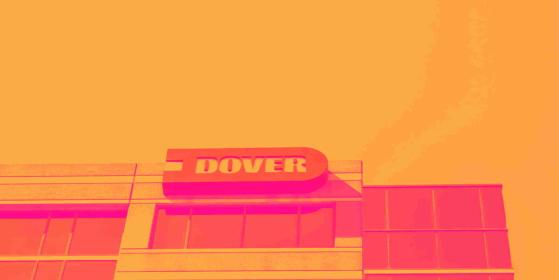Stock Story -
Manufacturing company Dover (NYSE:DOV) reported results ahead of analysts' expectations in Q2 CY2024, with revenue up 3.7% year on year to $2.18 billion. It made a non-GAAP profit of $2.36 per share, improving from its profit of $2.05 per share in the same quarter last year.
Is now the time to buy Dover? Find out by reading the original article on StockStory, it's free.
Dover (DOV) Q2 CY2024 Highlights:
- Revenue: $2.18 billion vs analyst estimates of $2.15 billion (1.4% beat)
- EPS (non-GAAP): $2.36 vs analyst estimates of $2.21 (6.7% beat)
- Gross Margin (GAAP): 37.7%, up from 36.4% in the same quarter last year
- Free Cash Flow of $122.1 million, similar to the previous quarter
- Organic Revenue rose 5% year on year (-3% in the same quarter last year)
- Market Capitalization: $24.23 billion
A company who manufactured critical equipment for the United States military during World War II, Dover (NYSE:DOV) manufactures engineered components and specialized equipment for numerous industries.
General Industrial MachineryAutomation that increases efficiency and connected equipment that collects analyzable data have been trending, creating new demand for general industrial machinery companies. Those who innovate and create digitized solutions can spur sales and speed up replacement cycles, but all general industrial machinery companies are still at the whim of economic cycles. Consumer spending and interest rates, for example, can greatly impact the industrial production that drives demand for these companies’ offerings.
Sales GrowthA company’s long-term performance can indicate its business quality. Any business can put up a good quarter or two, but many enduring ones tend to grow for years. Unfortunately, Dover's 3.8% annualized revenue growth over the last five years was sluggish. This shows it failed to expand in any major way and is a rough starting point for our analysis.
We at StockStory place the most emphasis on long-term growth, but within industrials, a half-decade historical view may miss cycles, industry trends, or a company capitalizing on catalysts such as a new contract win or a successful product line. Dover's recent history shows its demand slowed as its annualized revenue growth of 1.9% over the last two years is below its five-year trend.
We can dig further into the company's sales dynamics by analyzing its organic revenue, which strips out one-time events like acquisitions and currency fluctuations because they don't accurately reflect its fundamentals. Over the last two years, Dover's organic revenue averaged 2% year-on-year growth. Because this number aligns with its normal revenue growth, we can see the company's core operations (not M&A) drove most of its performance.
This quarter, Dover reported reasonable year-on-year revenue growth of 3.7%, and its $2.18 billion of revenue topped Wall Street's estimates by 1.4%. Looking ahead, Wall Street expects sales to grow 2.6% over the next 12 months, a deceleration from this quarter.
Operating Margin Operating margin is an important measure of profitability. It’s the portion of revenue left after accounting for all core expenses–everything from the cost of goods sold to advertising and wages. Operating margin is also useful for comparing profitability across companies with different levels of debt and tax rates because it excludes interest and taxes.
Dover has been a well-oiled machine over the last five years. It demonstrated elite profitability for an industrials business, boasting an average operating margin of 15.6%. This isn't surprising as its high gross margin gives it a favorable starting point.
Analyzing the trend in its profitability, Dover's annual operating margin rose by 2.4 percentage points over the last five years, showing its efficiency has improved.
This quarter, Dover generated an operating profit margin of 17%, up 1.5 percentage points year on year. This increase was encouraging, and since the company's operating margin rose more than its gross margin, we can infer it was recently more efficient with its general expenses like sales, marketing, and administrative overhead.
EPS Analyzing long-term revenue trends tells us about a company's historical growth, but the long-term change in its earnings per share (EPS) points to the profitability of that growth–for example, a company could inflate its sales through excessive spending on advertising and promotions.
Dover's EPS grew at a solid 10.3% compounded annual growth rate over the last five years, higher than its 3.8% annualized revenue growth. This tells us the company became more profitable as it expanded.
Diving into Dover's quality of earnings can give us a better understanding of its performance. As we mentioned earlier, Dover's operating margin expanded by 2.4 percentage points over the last five years. On top of that, its share count shrank by 6%. These are positive signs for shareholders because improving profitability and share buybacks turbocharge EPS growth relative to revenue growth.
Like with revenue, we also analyze EPS over a more recent period because it can give insight into an emerging theme or development for the business. For Dover, its two-year annual EPS growth of 8.2% was lower than its five-year trend. We hope its growth can accelerate in the future.
In Q2, Dover reported EPS at $2.36, up from $2.05 in the same quarter last year. This print beat analysts' estimates by 6.7%. Over the next 12 months, Wall Street expects Dover to grow its earnings. Analysts are projecting its EPS of $9.12 in the last year to climb by 4.1% to $9.49.
Key Takeaways from Dover's Q2 Results We enjoyed seeing Dover exceed analysts' revenue, organic revenue, and EPS expectations this quarter. We were also glad its full-year EPS guidance slightly topped estimates. Overall, we think this was a really good quarter that should please shareholders. The stock remained flat at $176.33 immediately following the results.
